https://podcasts.google.com/feed/aHR0cHM6Ly9hbmNob3IuZm0vcy8zOWE1NDkzYy9wb2RjYXN0L3Jzcw/episode/NzNhZWM3MjAtZjdhYS00MWNiLWEyMjItMzE0NDk1YWJmZGM5?sa=X&ved=0CAUQkfYCahgKEwiQrqX1jbr_AhUAAAAAHQAAAAAQqwE
https://anchor.fm/s/39a5493c/podcast/rss
https://podcasts.google.com/feed/aHR0cHM6Ly9hbmNob3IuZm0vcy8zOWE1NDkzYy9wb2RjYXN0L3Jzcw/episode/NzNhZWM3MjAtZjdhYS00MWNiLWEyMjItMzE0NDk1YWJmZGM5?sa=X&ved=0CAUQkfYCahgKEwiQrqX1jbr_AhUAAAAAHQAAAAAQqwE
https://anchor.fm/s/39a5493c/podcast/rss
H.H. Norwood, born in Berwick, Nova Scotia was captain of the Arctic whaler Balaena. He taught Jujiro Wada nautical skills and navigation. He retired early from whaling and had health issues, causing him to move back to Nova Scotia, but in later years he participated in the Klondike gold rush as an inspector of mines for the Canadian government. E.T Barnette, the first mayor of Fairbanks, sent Jujiro Wada over to Dawson City, where he told Norwood of the gold strike by Felix Pedro in the Tanana plain. A local newspaper article mentioned it and this caused the Tanana stampede.
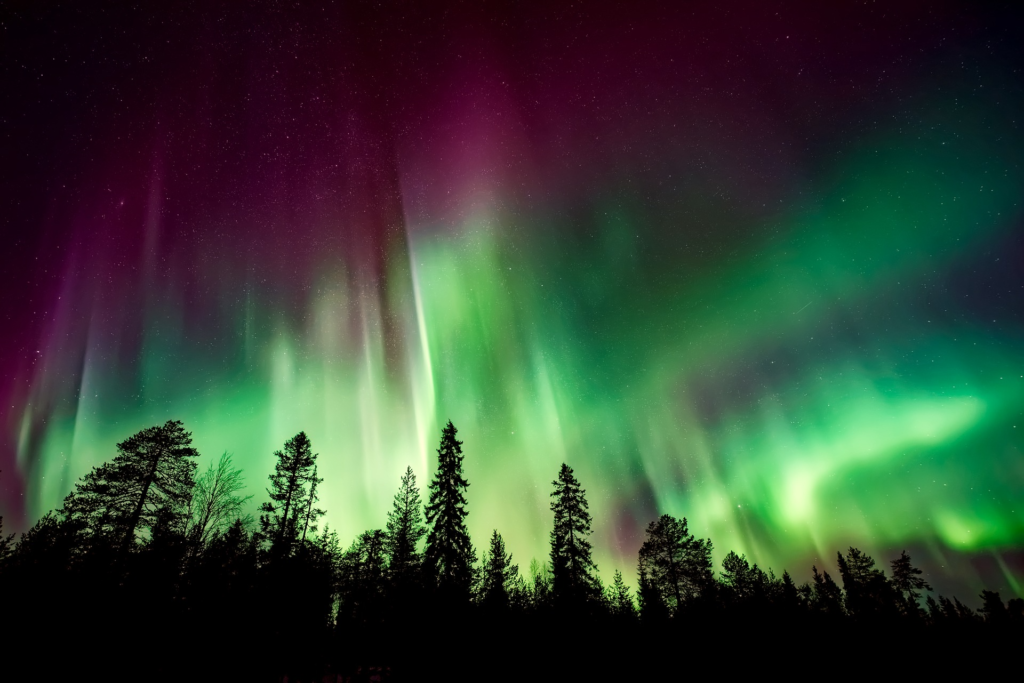
In 1892, when Jujiro Wada first reached the Arctic, he saw the Northern Light for the first time on his life. One second he thought it was a rainbow, but then it changed color, kept moving, shaped difficult forms. One of his fellow whalers, an Eskimo, told him it comes closer by whistling a tune with your mouth. As Jujiro Wada spent an exceptional amount of time in outdoor activities under the open sky in the Yukon and Alaska, the biography on Wada by author Y. Tani is titled “The samurai who chased the aurora”.
About Wada`s sailing: read further at 1907年10月へのリンク ,
About Wada`s hunting: read further at 1895年へのリンク,
About Wada`s mushing: 1892年へのリンク
Ancient Inuit legends about Northern light, often are related with the afterlife. Northern Light appears when a soul leaves this world and rises up to heaven. It is said to be a path which is made clear by lights shining on it. In Greenland people also tell a legend that the spirits are playing soccer using a walrus skull for a ball. This then causes the Northern Light.
For more details on Wada`s travel see Life History.
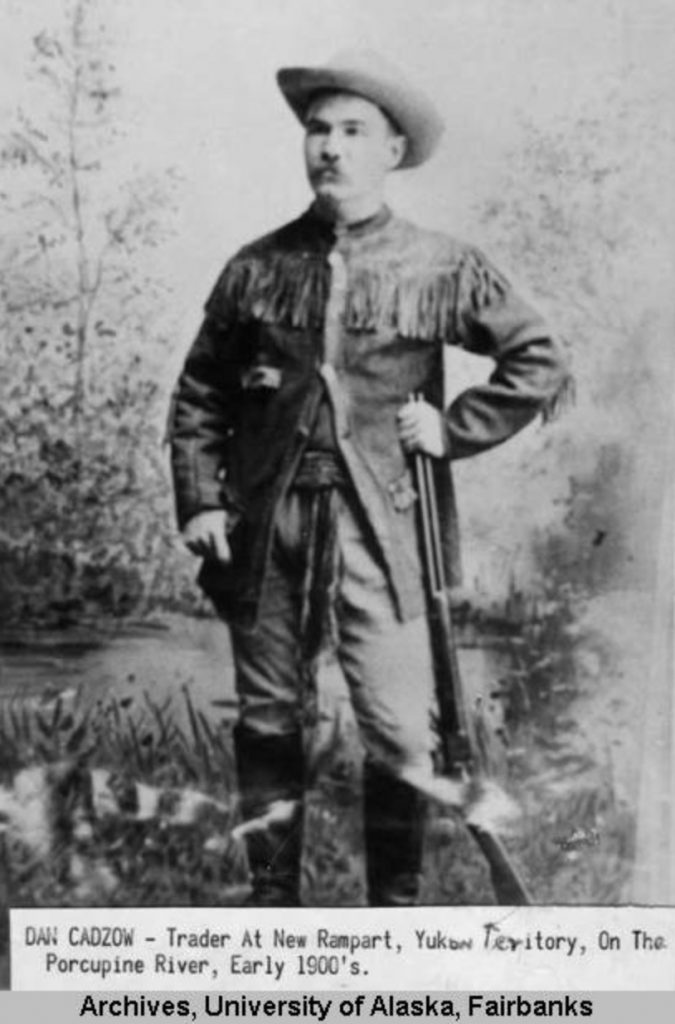
In 1907 Wada moved from Dawson to Herschel Island, with 6 dogs and a dog sled. The route brought Wada also to Rampart House. This was an old trading post run by independent trader Daniel Cadzow. The small settlement located at the Yukon-Alaska border, was a crossroad of people of different ways of life. After a winter on Herschel Island, Wada made a 1,600 mile solitary trip back to Dawson by dog sled. During grouse hunting the sun and snow blinded his eyes. When Wada arrived at Rampart House, his eyes were dripping wet from snow-blindness, which Cadzow mistook for tears of joy for a safe arrival, and Cadzow started to weep as well.
In 1907 Jujiro Wada traveled from Dawson to Herschel Island, and at Porcupine River his guide left him,
insisting Wada easily travel alone. During the last leg of his solitary travel, Wada bore witness of an
Eskimo struggling for his life with a polar bear, after his rifle failed.
In the earlier days of Yukon and Alaska, when pioneers like Wada explored the area,
among other animals, bears also were still hunted for their fur. We know from reports
that a succesful bear hunt still formed a risky thing to try.
Out in the field, skin and flesh are largely seperated,
but to save time, its skull often is still attached. The bear skin can weigh 200 kg.
Just walking with such a load is very tiresome, but then the landscape doesn`t make it easier.
Bears are most easy to track during fall, as they crowd around salmon grounds, or in spring when
snow makes place for fresh green sprouts. Most animals gather in the same areas where beavers build their structures.
When carrying your bear skin past these salmon grounds, you have to cross beaver ponds, and a lot of wet landscapes.
Beaver ponds sometimes have very deep spots, and when you loose your balance, the bear skin on your back
then pulls you down. In spring melting snow creates a lot of fresh creeks. To keep your cloths dry,
it`s best to jump over them, but carrying a bear skin makes jumping completely out of the question.
Men hunting bears are known to put on thigh-high boots, but even that doesn`t prevent them for getting soaking wet.
The bear meat is left where it was, and coyotes and birds will take care it disappears within 1 day.
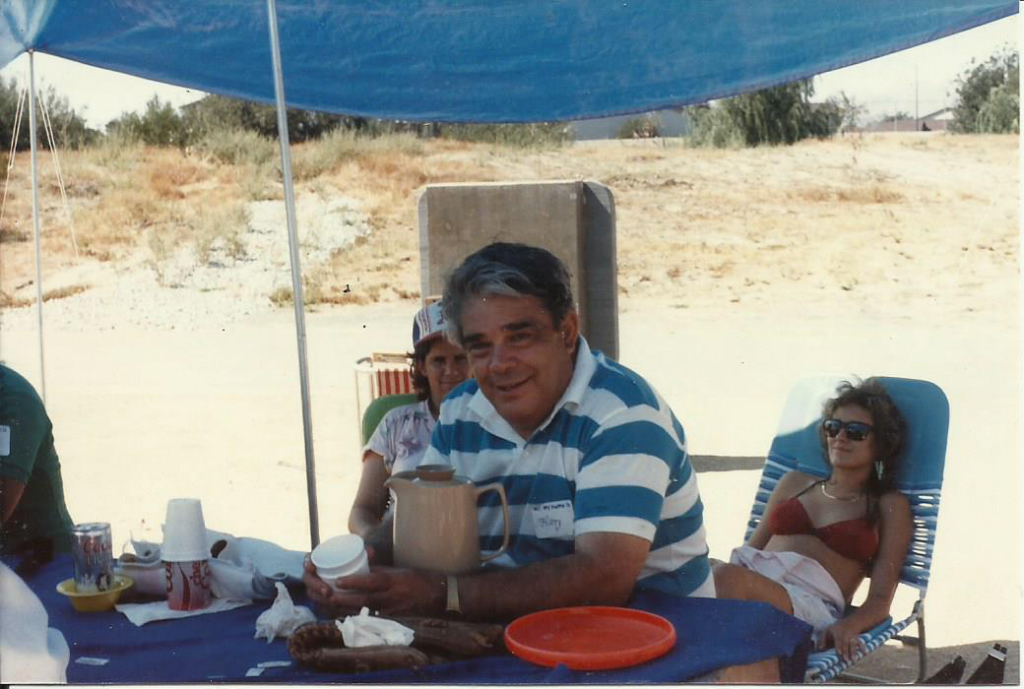
-teller- Michael O’Hare-
The company my dad worked for in the early sixties would send him from time to time to the Los Angeles area for business. My dad had a pilot’s license and would fly the company plane there. He always visited Uncle Harry on those trips and we, (my brother and sisters and I), enjoyed the stories he told us about his visits with his brother.

When they lived in San Jose they had a big old house. I have memories of an elevator in the house and we kids would ride it up and down. I wasn’t sure if my memory was correct so I asked my cousin Ron and he says he thinks it might have been a dumbwaiter. He’s probably right. Whatever it was we had a lot of fun riding in it.
In the front of the house was a big swimming pool that needed to be repaired. My father along with Uncle Harry and I think Uncle Richard was there, worked on repairing it. There was no water in the pool and I walked around in it and went to the deep end. I thought it was so cool to be in the deep end with no water. The edge of the pool seemed so high up.
The house was later torn down and a six lane freeway now runs through where the house once stood.
Uncle Harry was an inventor. He created many different products. His most famous one is Ty-D-Bol, which is a toilet bowl cleaner. He developed it in 1958 and sold the company in 1960.
From 1968 to 1984 one of the most famous commercials on TV was for Ty-D-Bol. It featured a man in a yachting uniform driving a boat in the toilet tank. He was called the Ty-D-Bol man. It became an American icon. People today still remember the Ty-D-Bol man and comedians sometimes mention him in their monologues.
He invented other types of cleaning materials, a swimming pool chlorinator and a water filter system.
He was developing the water filter system in the 1980’s. The company was called HOH Water Technology. He lived in Thousand Oaks, California at that time. That’s a city about an hour drive north of Los Angeles. My father and mother lived there for a few months so my father could help Uncle Harry with building the filter.
https://www.latimes.com/archives/la-xpm-1988-01-19-fi-37149-story.html
The rights of the filter were sold a couple of times to different companies and Ron taught the workers the technology of how to use it until he retired last year.
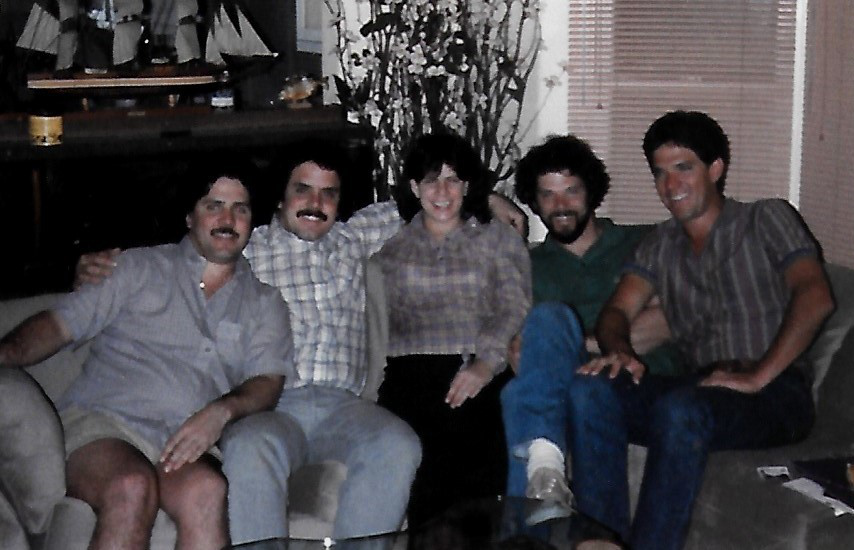
My father always told us a story that in the late 1940’s and early 1950’s Uncle Harry invented an anti-gravity ball or machine. The U.S. military learned about it and took it away from him.
Uncle Harry was fun to be around. He always had us laughing.
When he lived in Thousand Oaks he kept asking me to move down there. He told me he had committed his life to Jesus Christ and became a Christian and wanted me to teach the Bible to him. I eventually did move there in 1985 and stayed 2 years.
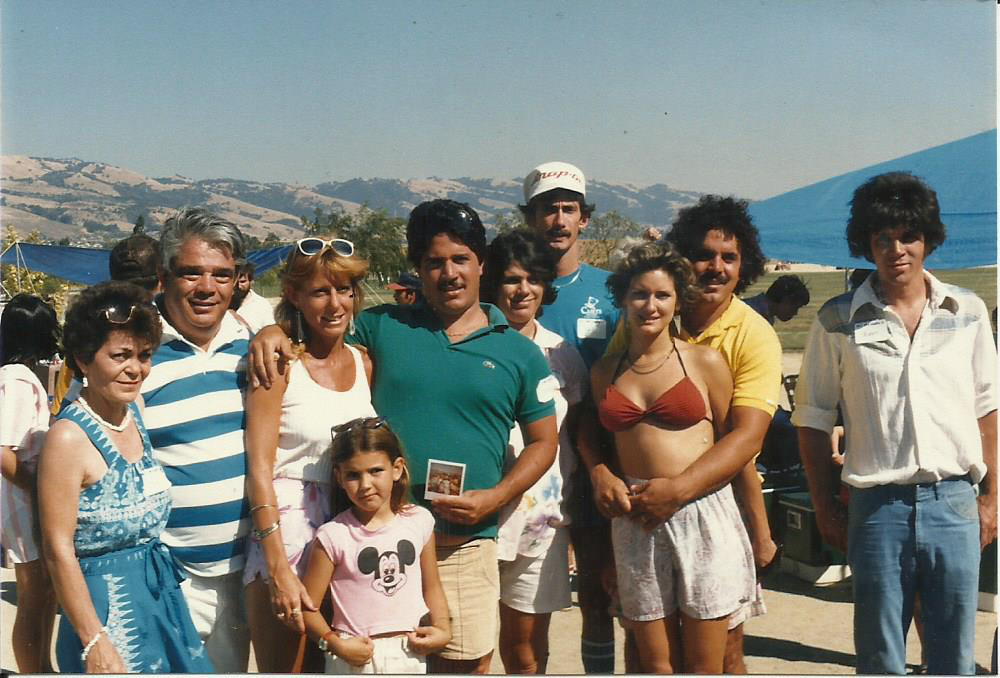
Whenever I visit with other relatives, Uncle Harry always comes up in conversation and memories of him shared.
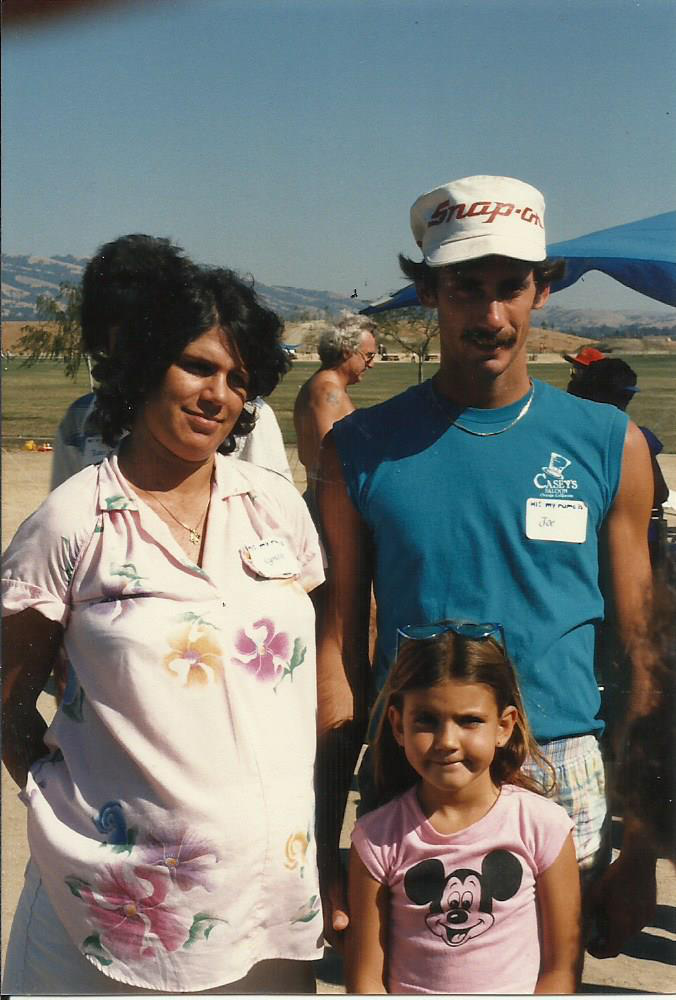
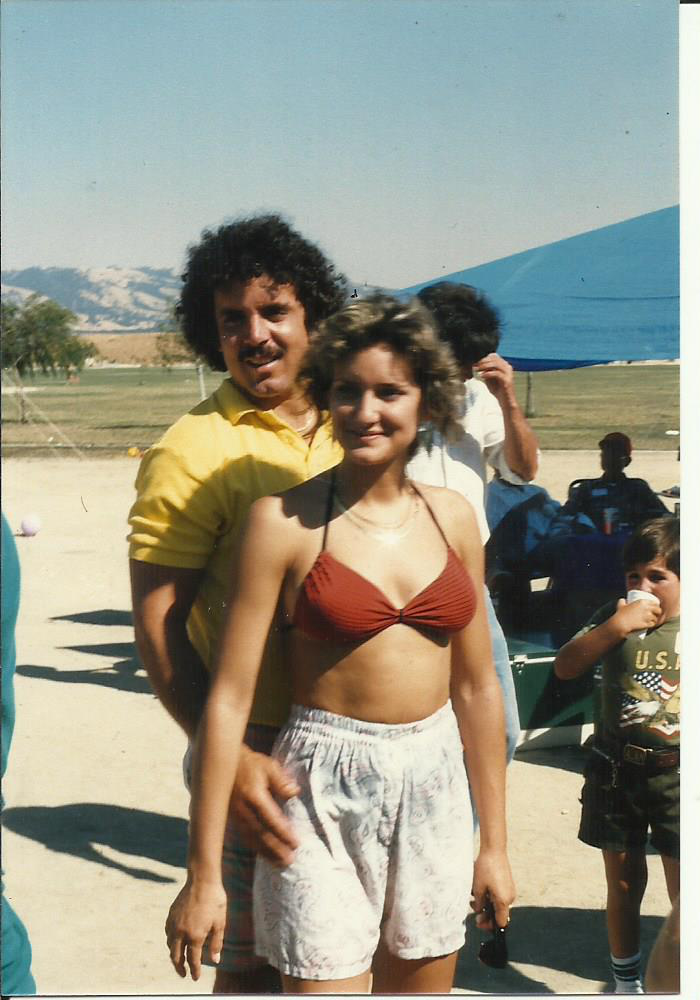
Jujiro Wada’s only daughter Helen Silveira —Helen Silveira (married 5 times): children Eddy, Harry, Donald, Juanita, Leonard, Adamae and Edith O`Hare; Harold, Lorraine, Lucille, Robert, Ruth, Norma, and Melvin Wight; Richard M. Medeiros; Marilyn Peters
-by Michael O’Hare-
Uncle Harry was the second child of Harry O’Hare and Helen Silveira Wada. He was named after his father.
He was born May 4, 1920 in Waterloo, Iowa. This past May 4th was his 100th birthday.
He and my father were close growing up since there was only a year’s difference in their ages.
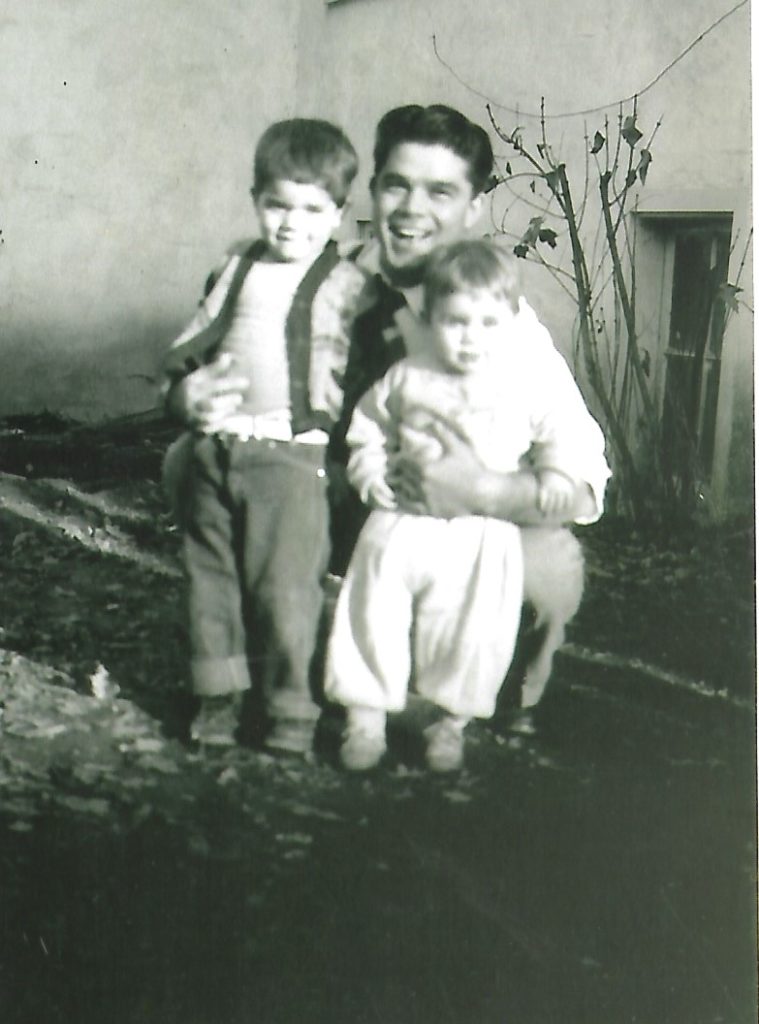
by Michael O’Hare
Uncle Harry was the second child of Harry O’Hare and Helen Silviera Wada. He was named after his father. He was born May 4, 1920, in Waterloo, Iowa. This past May 4th was his 100th birthday.
Harry and my father(Edward) were close growing up since there was only a year’s difference in their ages.

Harry was married to Elvira Marie Falcone. She grew up on Plum Street in the house next door or a couple of houses down, (can’t remember which), from my grandmother Helen’s house in San Jose, California.
They had two sons:
As children, my siblings and I called Elvira by her middle name Marie. She was a wonderful lady. So kind and nice. In later years she worked at a stationery store and if my brother and sisters and I were with my mother in town we always stopped at the store to see her. When I was older I would also stop and see her. If I needed any stationery supplies I always went there to buy them so I could visit with her.
Harry and Marie separated and Harry met Doris Mae Truesdell.
Harry and Doris had seven children:
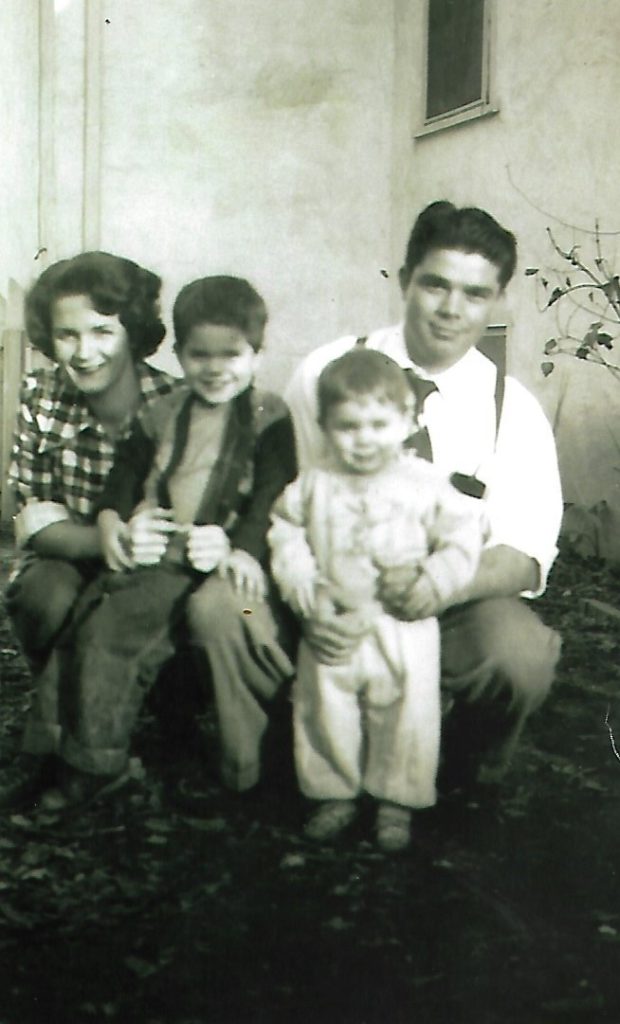
Aunt Doris was a wonderful woman. Very kind and caring. I remember her smile and her laughter. Sadly she passed away in 1972 in a car accident. It shocked us all when we heard the news.
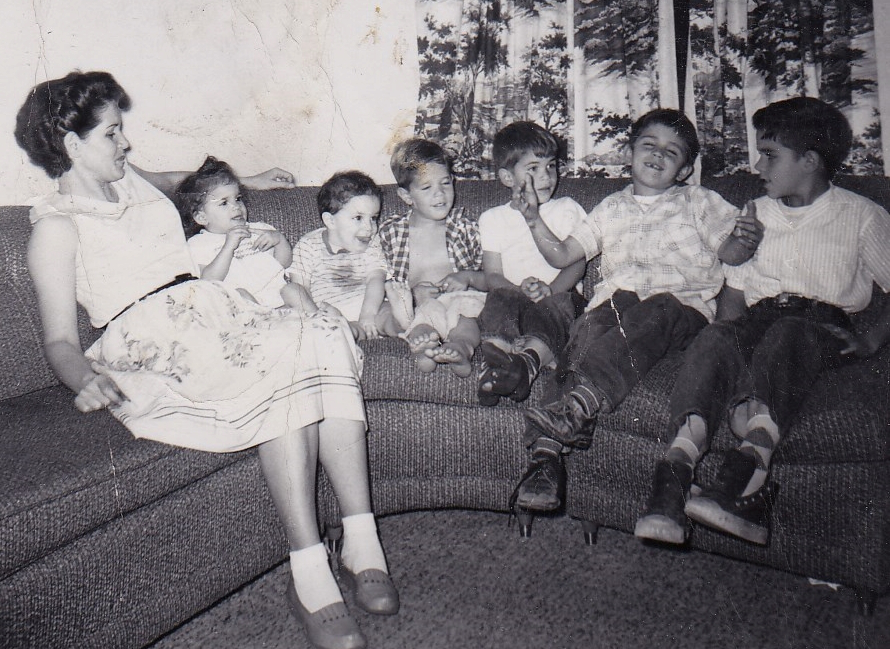
We cousins played together when we were young. Uncle Harry and his family moved to Los Angeles and we rarely saw them. Every once in a while they would come to Santa Clara and visit us and my family visited them when they lived in Anaheim in the Los Angeles area in 1970.
They lived near Disneyland. They had friends who worked there and they got us a lot of tickets for the rides so we didn’t have to buy any. That was a fun time.
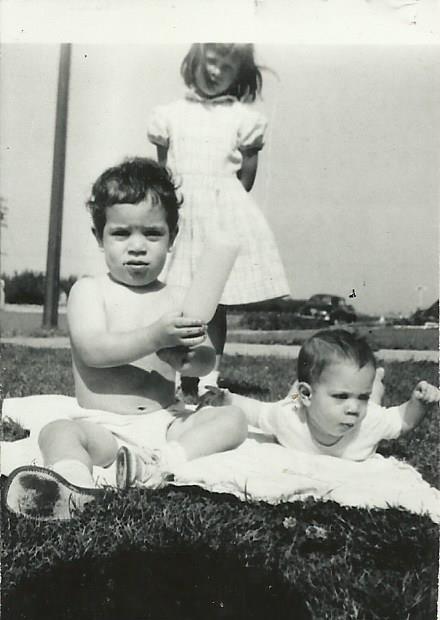
The house they lived in had a swimming pool. It was summer time when we were there so it was hot. The older cousins jumped off the roof of the house into the pool. I watched them and thought how fun that would be. I never did it because I was afraid of heights.
After that trip we didn’t see them for several years. I’ve reconnected with some of my cousins in the last few years and I’m enjoying getting to know them.
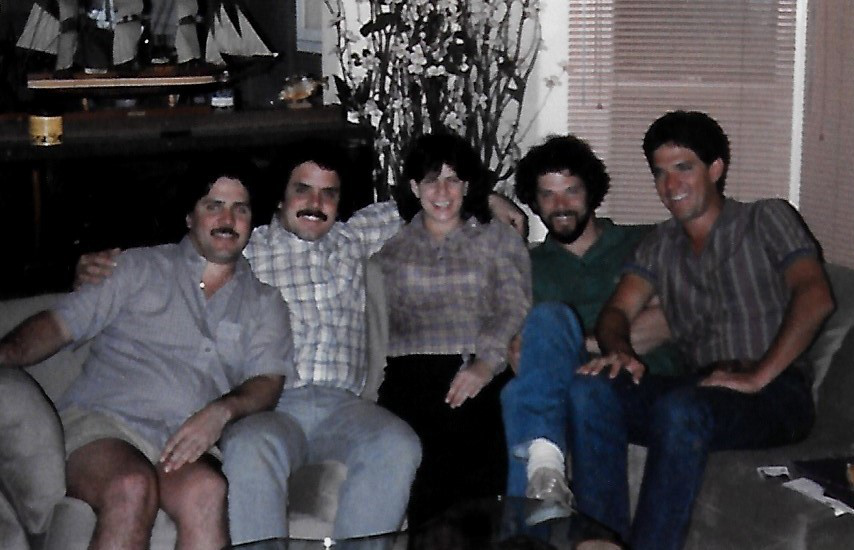
To be continued
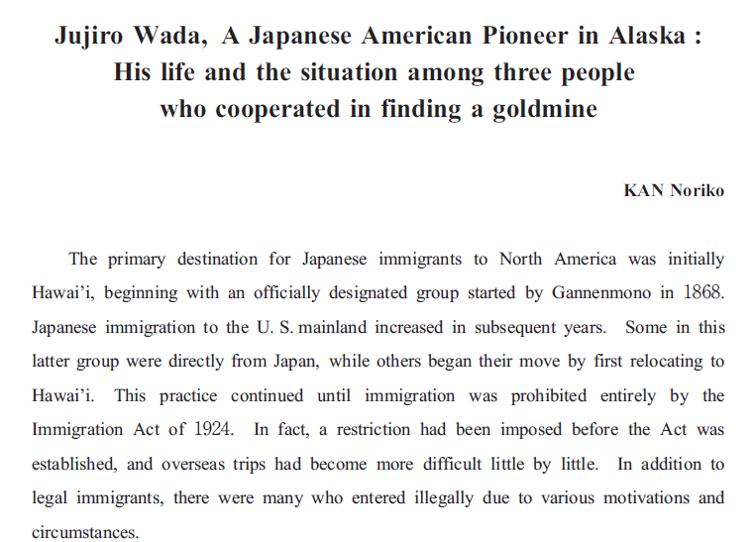
This paper focuses on an illegal immigrant named Jujiro Wada who stowed away on a ship bound for the U. S. mainland in 1892. The first section introduces the research that was conducted in both Ehime, Japan and Alaska, U. S. A.
The next section overviews the resources collected in both locations and describes Wada’s individual immigration history.
Wada is particularly notable for his pioneering experiences in Alaska and Canada, which were frequently reported in the newspapers. However, his exposure to the media diminished after he found a goldmine with two other people. He then remained in obscurity until he died alone in 1937. The third section profiles the two people with whom he found the goldmine, paying special attention to their ethnic backgrounds.
Finally, the paper compares the tone of the later lives of these three people, contrasting the world’s international situation with their own, and concludes that the fading of Wada’s name from the media was caused by the pervading fear of the “Yellow Peril.”
The Aurora Walk is a short path along the Ishite River by Wada’s statue, and has been recommended as one of the Top views in Matsuyama. However, the path is unfamiliar to both tourists and residents. The walk is primarily maintained by senior citizens of Hinode. However, the Welfare committee requested help from Takunan Junior High School.
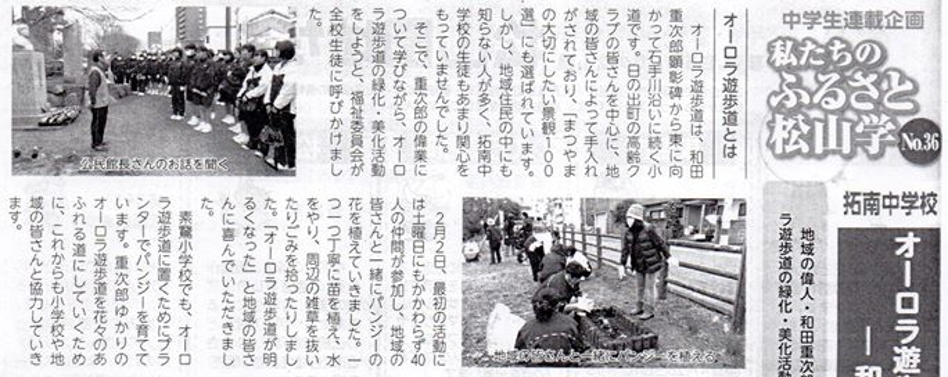
On Sat. Feb.2nd 2020 Students gathered with senior citizens at Aurora Path to pick up trash, remove weeds and plant pansies Soga Elementary School also helps clean-up Aurora Path.
Takunan Junior High School students interview the local community about Aurora Walk beautification and clean-up activities. 4 student members of the school’s welfare committee interview locals about Junjiro Wada after clean-up activities of the Aurora Walk (a short path along the Ishite River by Wada’s statue, which was erected in 2010)
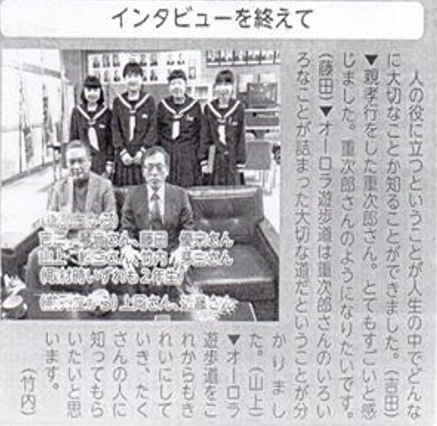
Students: What motivated you to promote and make Wada Jujiro more known to the public? Mr. Ueoka: We wanted to let the people of Hinode, where Wada grew up, know about Wada’s pioneer spirit and devotion to his mother, so we founded JWMA ( Jujiro Wada Memorial Association )
Students: What message would you like to deliver to Takunan Junior High School? Mr. Ueoka: Wada went abroad at the young age of 17, pioneered an unknown land, and faced racial discrimination. He was dragged down by adversity and even became a crime suspect. Despite the adversity that tried to drag him down, he went on to succeed. We’d like for students to know his hardships. and to apply his experiences to their daily lives. His experiences may encourage those struggling to cope with difficulties in their lives.
Students: What message would you like to deliver to Takunan Junior High School? We would like the local community, students, and elders, to make a habit of regularly maintaining this path, and in doing so, to foster a good community. Students: How do you see this path in the future? Mr. Kondo: We would be thrilled for you to visit this path to learn more about Wada , who was an inspiration to many.
x